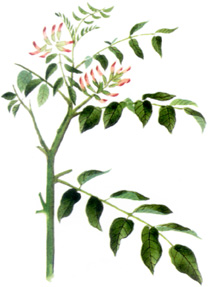
- Have you ever drunk Pitter's tea?
D. Maria's eyes searched me out, sparkling above her pretty smile which the passing years had failed to age.
- Have you tried it?
No. I did not know what it was. I had only been in Macau for a few years. I was new to this land.
After a few days, I received a little parcel of bright pink paper, wrapped up Chinese style. I opened it carelessly and a fine, chestnut-coloured powder smelling of lemons spilled out onto the table.
It smelled delicious, Dr. Pitter's tea.
And it was a secret. The recipe was a secret known only to the family...
Sin-cap or Dr. Pitter's Tea.
It could probably be said that the most popular and the most famous tea drunk by the Portuguese population in Macau was, even up to the middle of this century, sin-cap tea, also known as Pitter tea or Dr. Pitter's tea.
The recipe for the tea was a jealously guarded family secret which had been kept for such a long time that there was wild speculation as to its ingredients by those who had tried it.
In his book Macau e a Assistência (1), Dr. José Caetano Soares discusses the variety of teas which could be found in the markets of Macau at the time when he was writing in the fifties. He describes teas with tangerine and orange peel and others which were less aromatic, made with the petals of several kinds of flowers such as Arabian Jasmine (Jasminum sambac (L.) Ait.), rose, camellia, osmanthus (Olea fragrans L.) mock lime (Aglaia odorata Lour.), Chloranthus inconspicuus L. amongst other plants. These kinds of teas were commonly grouped together as "scented caper teas" as they were all aromatic. For the finer teas the part which was used was not the leaf but rather the buds which had not yet fully opened out. Capers (Caparis spinosa L.) were added to these buds as they have digestive qualities and are much enjoyed by the sons of ancient Albion. We learn from the same source that sin-cap tea was a "speciality which was highly valued in Macau". The Macanese name, however, is no more than a corruption of the English "scented caper" as sinologists have proved that it is definitely not a Chinese word and, Dr. Caetano Soares wrote, "it is completely unknown outside the Macanese businesses which have most contact with the inhabitants and customs of the city. One of the people who distributed this tea, but who did not actually invent it, was a surgeon, Dr. Vicente Pitter, a foreigner who had been born in Macau and had lived there for a long time, linking his name to that of a Portuguese family through marriage".
There is still a very interesting little document in existence which deals with Pitter tea. It is a letter written in 1907 by the Macanese Francisco Pereira Marques to his cousin, João Feliciano Marques Pereira in which he writes: "pokes of sin-cap are sold in all the Chinese chemists and they are placed in a cardboard box. Dr. Pitter's family knew how to prepare a special, powdered sin-cap. When he was still alive, we used to go to his home for dinner on his birthday or that of any other member of the family and he would make me drink a cup of sin-cap right after a rich meal". (2)
The recipe
This famous tea was still being made in Macau in the sixties and the seventies by D. Maria Tereza Pitter, Dr. Pitter's granddaughter (3). It was sold in little pink tissue paper pokes and resembled a fine, chestnut-coloured dust with a strong aroma reminiscent of lemon or orange. The infusion was prepared like any ordinary tea and it tasted very pleasant. It was believed to be very beneficial for stomach complaints.
D. Maria Tereza Pitter still lives in Macau and was kind enough to provide me with the original copy of the famous recipe. It was kept a family secret and was copied into an old notebook belonging to her aunt in 1909 (4) and then passed on to her.
The household remedy was considered to be an effective aid to digestion and was used as a prophylactic after a heavy tea or rich banquet. It was also highly esteemed in Macau as a cure for gastrointestinal problems with different causes. It is composed of eight ingredients used in traditional Chinese medicine, almost all of which are specifically intended for helping illnesses connected to the intestines:
1. San cha (山楂) - hawthorn (Crataegus cuneata Sieb. et Zucc.) the fruit of which is used as a digestive aid and to counteract diarrhoea. The fruit of the C. pinnatifida Bunge is used for the same ailments, as is that of the C. pentagyna Waldst. et Kit..
2. Mak nga (麥芽) - barley shoots used for gastrointestinal problems.
3. Wu iok (烏藥) the root of the three-nerved spicebush (Lindera strychnofolia Vill.). It is used as an aromatic digestive aid.
4. Chang pei (陳皮) - orange peel, used for indigestion.
5. Chun Pui (川僕) - tendril-leaved fritillary (Magnolia officinalis Reh. et Wils.). The bark is used as an antispamodic and an aid to digestion.
6. San kok (神粬) - a medicated leaven which is sold in blocks.
7. Pau sot (泡術) - Atractylis ovata Thunb. (also Alia ctylodes lancea) but this classification is not definitive. The root of this plant is used as an aromatic tonic for chronic gastroenteritis.
8. Fang feng (防風) - Saposhnikovia divaricata Benth. et Hook.. The roots of this plant are used as an analgesic and an antipyretic.
Patrício's Tea
The people of Macau have always more or less confused Dr. Pitter's tea with Patrício's tea. Nevertheless, elderly residents claim that both remedies were prepared for the same complaints but have different ingredients. As Patrício's tea also has a secret recipe nobody can tell precisely what its ingredients are.
Ingredients of Dr. Pitter's Famous Tea
Illustrations by Chan leng Hing 1988
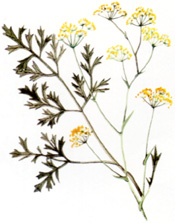 Saposhnikovia divaricata Benth. et. Hook.
Saposhnikovia divaricata Benth. et. Hook.
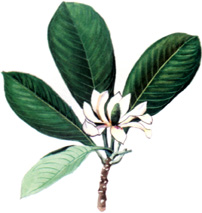 Magnolia officinalis Reh. et Wils.
Magnolia officinalis Reh. et Wils.
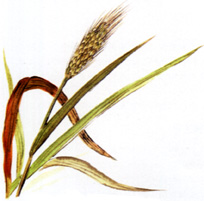 Hordeum sativum (L.), vulgare (Hack)
Hordeum sativum (L.), vulgare (Hack)
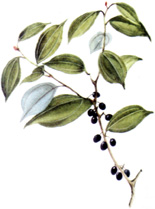 Lindera strychnofolia Vill.
Lindera strychnofolia Vill.
 Atractylis ovata Thunb.
Atractylis ovata Thunb.
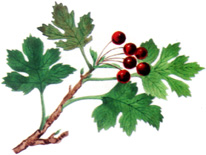 Crataegus cuneata Sieb et Zucc.
Crataegus cuneata Sieb et Zucc.
D. Maria Margarida Gomes is almost certain that Patrício's tea is the same as wong chi cha (literally yellow paper tea). This tea was sold in little yellow paper pokes in Macau's better herbalists up to the seventies. Other people compare the tea to a recipe which was found in an old notebook which belonged to a Macanese lady. The recipe is as follow:
Flatulence or stomach pains
the skins of 15 dried kaki figs
the pips of 15 jujubes
the pips of 15 dried longans
9 mazes of "old tea"
8 "condorins" of liquorice
1 pinch of aniseed
3 nips of mint
2 pieces of dried orange peel boiled in 1/2pt of water until it becomes a syrup
The original version of this recipe is very interesting as it is written in the old Portuguese dialect of Macau. It also indicates that a wide variety of ingredients went to make up the tea.
The "tapuses de Figo caque secco" are the dried outer skins of the persimmon Diospiros kaki L.). Their medical application also extends to include use as an antiphlogistic agent and an emetic although the active agent has not been precisely indentified. In Macau the word "tapuz" is used to mean toque or hood. "Tapuz" is a derivation of a Turkish word "tarpuz" which is used to describe the ridged toque, usually made of brocade, which women wore under their veils. The similarity between the ridges in the skin of a persimmon and the Turkish women's toques seems to be the reason for the introduction of this word into the Macanese vocabulary.
The "grãos de Massaãs vermelhas" are the little red berries or their seeds from the jujube. Zizyphus jujuba Mill. is used in many medicines to treat gastrointestinal complaints.
The "grãos de Longans seccos" are the dried fruits of the Euphoria longan (Lour.) Steud.. The pips are used in Chinese medicine as a styptic agent.
The "feijão preto" is the soya bean and is called wu tau (烏豆) in Chinese. It is a species of the Fabacea genus enjoying many different names.
It has been widely studied, particularly in America where its nutritional content is of interest. The most common name for it is Glycine hispida L.. It is used to make sutate, a Chinese drink, and tafu mui and tafu fa (soy sauce and beancurd). It is also used to grow nga choi or tanka choi (bean sprouts). It is used in popular medicine for treating female ailments and as a general tonic due to its high level of proteins and vitamins.
The "chá velho" is the common tea leaf from the Thea sinensis L. plant (also T. bohea L., T. cochinchinensis Lour., T. assamica Mast., T. chinensis Sims., T. viridis L., Camelia bohea Griff., C. theifera Griff., C. viridis Link.). Because of the action of the alkaloids in it, tea is a stimulant which can counteract muscular and mental fatigue. It is also used in Chinese medicine as a cardiotonic, a diuretic and an intestinal astringent. According to reports, "old tea" is common tea which has been scalded and then left to dry out and put in special tins or bamboo boxes.
"Arcassús" is liquorice and for the purposes of this recipe probably either Glycyrryza uralensis Fisch. from China or Glycurryza glabra L. from Europe was used. Formerly, European liquorice was sold in the apothecaries in Macau.
"Erva-doce", (aniseed) is called siu wui heong (小茴香) or tim siu wui (甜小茴) in Chinese. It is a member of the Pimpinella genus and originally came from Egypt. It is commonly grown in Portugal and is still frequently used in villages as a flavouring for liquors, confectionery and cakes. It is also used in popular medicine as a carminative agent for indigestion, flatulence and cholic, especially in children. In Macau aniseed used to be sold in the Portuguese apothecaries. The Chinese use Foeniculum vulgare Mill., which they also call siu wui heong for dyspepsia, cholic and other intestinal complaints. It can be substituted with sweet fennel (Foeniculum dulce G. Bauh., also Anetum dulce DC.).
The "Olhos de Hortelã de soupa" are the youngest shoots of the mint plant (Mentha) and they are used as a stomach calmant, a carminative agent, a stimulant and a diuretic.
The "casca secca de laranja" is widely used by the Chinese and is regarded as a highly efficient eupeptic.
When the recipe which has just been described is compared with the recipe for wong chi chá (黃紙茶), it seems likely that this is in fact the secret recipe for the famous Patrício's Tea. The recipe has been lost and so we are left with no alternative other than to offer hypotheses.
Some of the ingredients in Patrício's Tea
Illustrations by Chan leng Hing 1988
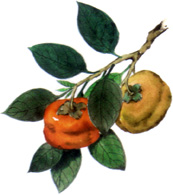 Diospyros kaki L.
Diospyros kaki L.
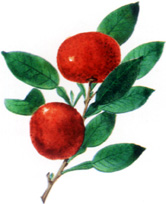 Citrus nobili Lour.
Citrus nobili Lour.
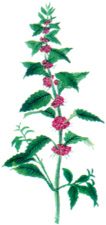 Mentha
Mentha
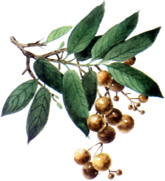 Euphoria longan (L.)Steud
Euphoria longan (L.)Steud
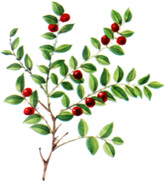 Zizyphus jujuba Mill.
Zizyphus jujuba Mill.
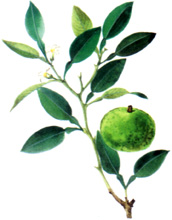 Citrus aurantium L.
Citrus aurantium L.
By comparing the composition of the two teas, it can easily be seen that they are two completely different remedies and are linked only by their efficacy as eupeptic agents.
The men
The famous Dr. Vicente Salatwichy Pitter
Just who was this Macanese man whose name has survived the passing years and remained engrained in the memory of his compatriots as a great doctor and the "inventor" of a "prodigious" remedy - his famous tea?
Vicente de Paulo was born in Macau on the 10th of January, 1813, and was christened on the 17th of the same month. The entry in the christening register shows that he was the son of Pedro Salatwichy (5) and Josefa Antónia Favacho, both of Macau. His paternal grandparents were André and Maria Salati Buliu from Italy and his maternal grandparents were Henrique and Quitéria Fransisca Favacho.
He studied medicine in Goa at some point and by 1847 he was already back in Macau where he married Hermelinda Joaquina Cortela Leiria in the Church of S. Lourenço on the 6th of November of that year. Hermelinda had been born and bred in Macau and was the daughter of the union of the two wealthiest families in Macau: the Leirias and the Cortelas.
Vicente de Paulo was thirty six years old at the time, while Hermelinda Maria was only nineteen. Hermelinda Maria died six years later in 1855 after having given birth to four children: Hermenegildo Joaquim, Maria de Assunção, Teresa Maria das Neves and Eugénia Maria.
Dr. Vicente de Paulo married out of his widowed state on the 16th of February, 1858, again in the Church of S. Lourenço. This time the bride was his sister-in-law Eugénia Norberta Cortela Leiria. She bore him three children: Maria da Purificação, Maria das Dores (both of whom died in childhood) and Maria do Carmo, born on the 25th of January, 1869, and died a spinster on the 9th of October, 1940.
On the occasion of Dr. Pitter's death on the 9th of June, 1882, the newspapers dedicated elaborate obituaries to him. The paper "O Macaense" of the 13th of July, 1882, mentioned the honours which had been bestowed upon him for his services to the community. He had been decorated with the Legion of Honour by several French warships for the assistance he gave during a cholera epidemic which ravaged Macau. The Portuguese Government awarded him the "Ordens da Conceição e da Torre e Espada".
Other newspapers praised his virtues as an honest man, a fervent practising Catholic and a worthy disciple of Father Leite and Father Gonsalves of the Mission Congregation, both of whom he always referred to with the greatest respect.
Patrício da Luz
Patrício was born to Francisco Borja da Luz and Ana Rosa da Luz in Macau in 1857. He studied in St. Joseph's Seminary and later took up employment in several different areas, always showing himself to be an exemplary employee who held his native land in high regard.
He married twice, the second time to Amália Maria da Encarnação, the daughter of Secundino da Encarnação and Etelvina Filipa Batalha.
Patrício da Luz died on the 10th of October, 1920, in a house at 13, Rua da Sé. He had served the Leal Senado faithfully for thirty six years, ten of them as a teacher and twenty six as a secretary. For several years he was headmaster of the Escola Central. (6)
On his death, he left behind a great reputation on Macau for being extremely intelligent and wise. In fact, although he was not a member of the nobility, he was one of Macau's illustrious sons.
The recipes seen in the light of Chinese medicine
As is generally known, the Chinese evaluate the action of any drug according to its taste and its nature ("hot", "tepid", "neutral" or "cold"). Apart from these two basic characteristics, the way in which the separate ingredients are combined is also important as this can affect their individual properties.
The five tastes are linked to the five organs of the body according to theories which date back to the times of the Sophists. Nature and taste, the two medicinal properties, can be effective in two ways: either through fighting the problem or through reinforcing the body as they are also linked to the principle of yin-yang (the duality which governs all Chinese thought), hei (the pneuma) and the blood system.
The series of relationships on which a Chinese medical diagnosis is established is nothing less than of the most advanced complexity. However, it is this logic, rooted in ancient times, which allows the Chinese doctor to concoct his recipes with comparative ease.
"Uneven", "even" and "complex", the recipes always rest on the principal characteristics of the ingredients and their relationship with the different organs and energy channels.
We shall now analyse the ingredients of the recipes one by one.
Dr. Pitter's Tea
Hawthorn
Crataegus cuneata Sieb. et Zucc.
(fam.: Rosaceae)
The berries are gathered at the end of Autumn and the beginning of Winter and they are either lightly toasted or left to dry in the sun. They are believed to be useful as a eupeptic agent.
Their taste is "acid" and "sweet" and their nature is slightly "tepid".
They are effective in the spleen, the pancreas and the stomach.
Mode of action: they facilitate digestion, tone the stomach, stimulate the blood system and eradicate blood clots.
Barley shoots
Hordeum vulgare L.
(fam.: Gramineae)
This is regarded as a eupeptic agent due to its taste and its nature which are, respectively, "sweet" and "neutral".
Mode of action: it tones the stomach and facilitates digestion.
Three-nerved spicebush
Lindera strychnofolium Vill.
(fam.: Lauraceae)
The root of this plant, lightly toasted or dried in the sun, is believed to stimulate the energy channels.
Its taste is "spicy" and its nature is "tepid".
It is effective in the stomach, the kidneys and the bladder.
Mode of action: it stimulates the energy channels, eliminates blood clots, aids the elimination of water and dissipates oedemas.
Orange peel (the pericarp of the citrine)
C. reticulata Blanco
(fam.: Rutaceae)
The pericarp is lightly toasted or dried in the sun and used with no further preparation. The older the pericarp, the better. This ingredient belongs to the group which stimulates the energy channels.
Its taste is "bitter" and "spicy" and its nature is "tepid".
It is effective in the spleen, the pancreas and the lungs.
Mode of action: it stimulates the energy channels, tones the spleen and the pancreas, eliminates mucus, prevents nausea and reduces sweating.
Tendril-leaved fritillary bulb
Magnolia officinalis Reh. et Wils.
(fam.: Magnoliaceae)
The specific properties of magnolia flowers disperse both wind and cold. The flowers are collected while they are still in the bud and they are dried in the sun and then pressed.
Their taste is "spicy" and their nature is "tepid".
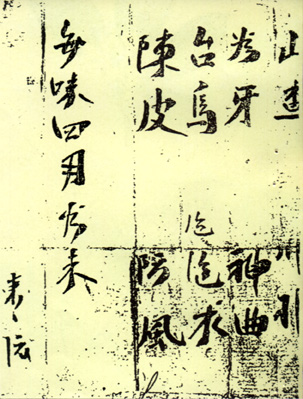
Facsimile of Dr. Pitter's famous household remedy which was kept a secret for many years (this copy has been lent by D. Maria Tereza Pitter).
They are effective in the lungs and the stomach.
Mode of action: they disperse wind and cold and clear the nostrils.
Medicated leaven
Massa medica fermentata
This is a drug with multiple applications which has already been described in a previous article***. It is believed to have eupeptic qualities.
Its taste is "spicy", its nature "tepid".
It is effective in the spleen, the pancreas and the stomach.
Mode of action: it tones the spleen, the pancreas and the stomach, stimulates the energy channels and aids digestion.
Atractylis ovata Thunb.
(fam.: Asteraceae)
The rhizome is used and it can be bought dried in branched pieces about 7cm long and 2cm in diameter.
Its taste is "sweet and bitter" and its nature is "tepid".
It is used to tone and stimulate the spleen, the pancreas and the stomach.
Mode of action: it tones the spleen and the pancreas, tones the pneuma, dries up humidity, aids urination and reduces sweating.
Fang feng
Saposhnikovia divaricata Benth. et Hook.
(fam.: Umbeliferae)
The roots are used in medicine once they have been dried.
Its taste is "sweet and aromatic" and its nature is "tepid".
It is used as an analgesic and an antipyretic.
It is effective in the blood system and the pneuma.
Conclusions
This appears to be a typical "even Chinese recipe composed of three eupeptic agents, two stimulants for the energy channels, one disperser of wind, one tonic and one analgesic.
Almost all of the ingredients are active in the region of the spleen, the pancreas and the stomach just as is required of a remedy to aid digestion or treat complaints in the intestine.
It is worth keeping in mind that "sweet" and "spicy" tastes (yin-yang) induce the elimination of yang as the spicy element induces sweating and the sweet element induces dissipation.
Patricío's Tea for flatulence or stomach pains
Persimmon skins
Diospyros kaki L.
(fam.: Ebenaceae)
The skins of this fruit are dried in the sun and can then be used with no further preparation. They are effective in stimulating the energy channels and act in the stomach region.
Their taste is "bitter" and their nature "neutral".
Mode of action: they stop hiccuping.
Jujube
Zizyphus jujuba Mill.
(Fam.: Rhamnaceae)
The seeds of the berry act as a tranquillizer and the fruit as a tonic for the energy channels. The seeds are dried and should be split when they are being boiled.
Their taste is "acid and sweet" and their nature is "neutral".
They are effective in the regions of the heart and the liver.
Mode of action: they tone the heart and the liver, calm the spirit, tone the blood and aid the effectiveness of any other remedy used in conjuction with them.
Dried longans
Euphoria longan L. Steud.
(fam.: Sapindaceae)
In Macau these are sometimes replaced with the seeds of the lychee (Litchi Sinensis Sonn.).
The kernel is dried in the sun and should be split before being used or toasted.
Its taste is "spicy" and its nature "tepid".
It is effective in the regions of the liver and the stomach.
Mode of action: it stimulates the pneuma, gets rid of cold, calms pains and clears any blockages.
The specific properties of the longan fruit are very different from those of the lychee seed.
The part which is used is a pulp from the dried fruit.
The taste is "sweet" and the nature is "tepid".
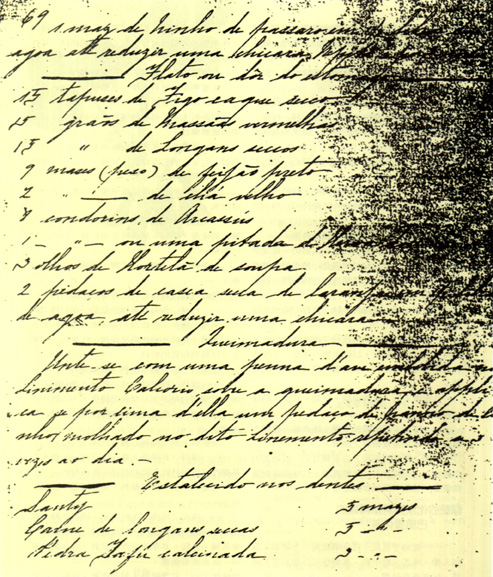
Facsimile of what was probably the recipe for Patrício's Tea which, according to the notes here, was suitable for "Flatulence and stomach pains" (reproduction of a page from a 19th century recipe book which originally belonged to D. Hermínia Figueiredo and was inherited by D. Maria de Lurdes Pacheco Borges).
It is effective in the regions of the heart, the spleen and the pancreas.
Mode of action: it tones the heart, the spleen, the pancreas and the blood and it calms the spirit.
The longan fruit, like the shavings from the antler of a deer, is believed to be a good tranquillizer.
Black bean
Glycine hispida L. Vilm.
(fam.: Fabaceae)
These beans can disperse heat and wind.
The taste is "spicy-sweet" and slightly "bitter" if the beans have been fermented with mulberry and mugwort leaves. Their nature is "cold". If they have been dried in the sun and then cooked and left to ferment in a preparation of Perilla frutescens and Ephedra sinica, their taste is "spicy" and their nature is "tepid".
They are effective in the regions of the lungs and the stomach.
Mode of action: they free external wind and heat and they act as a tranquillizer.
Liquorice
Rehmania glutinosa Libosch.
(fam.: Scrophulariaceae)
The stems are cooked in a bain-marie with wine and orange peel. Afterwards, they are dried in the sun until they are black on the outside and slightly gelatinous inside.
Its taste is "sweet" and its nature is slightly "tepid".
It is effective in the regions of the heart and the kidneys.
Mode of action: it tones the heart and reinforces yin.
Mint
Mentha
(fam.: Labiateae)
The stems and the leaves get rid of wind and heat.
Its taste is "spicy" and its nature is "cold".
It is effective in the regions of the liver and the lungs.
Mode of action: it disperses heat and cold, it clears the eyes and the head and it is good for skin eruptions.
Dried orange peel
Citrus reticulate Blanco
(fam.: Rutaceae)
The peel is dried in the sun and then either toasted or used with no further preparation. As was mentioned, the older peels are more effective. It stimulates the energy channels.
Its taste is "bitter and sweet" and its nature is "tepid".
It is effective in the regions of the spleen, the pancreas and the lungs. Mode of action: it stimulates the energy channels, it tones the spleen and the pancreas, it gets rid of mucus, it prevents nausea and it reduces sweating.
Conclusions
In terms of Chinese medicine, this recipe seems to be more appropriate for the treatment of colds than the treatment of stomach complaints. It is an "uneven" recipe, the larger part of the components stimulating energy and circulation while two of the ingredients are there to disperse heat and wind and one is a tonic for the blood.
It is possible that this recipe is a truly popular remedy, concocted by doctors who were not too familiar with classical Chinese medicine. It may even have been an authentic Macanese creation.
Both Dr. Pitter's Tea and Patrício's Tea were much loved by the Macanese in their time and the recipes for each were an integral part of the culture of the city. It seems that, like so many other fascinating aspects of Macau, these teas have been destined to fade from memory and become lost in the race towards capitalism which is now so evident in the city.
Neither the recipe for Patrício's Tea nor even the identity of Patrício himself can be proved beyond doubt. Nevertheless, it is worth making a record of some remnants of Macau's culture during the sixties and the seventies at a time when it seems that these small details are being condemned to indifference and neglect.
***In "Three Popular Household Remedies from Macau", Ana Maria Amaro, RC2.
NOTES
(1). Caetano Soares, J.: Macau e a Assistência - Panorama Médicosocial, ed. Agência Geral das Colónias, Lisbon, 1950, p. 454.
(2). Papers from the estate of João Feliciano Marques Pereira in the Manuscript Collection of the Library of the Geographical Society in Lisbon.
(3). D. Maria do Carmo Salatwichy Pitter was the youngest daughter from Dr. Vicente de Paulo S. Pitter's second marriage. She was born on the 25th of January, 1869, and died a spinster on the 9th of October, 1940. It was D. Maria who inherited the recipe for sin-cap tea and she in turn left it to her niece D. Maria Tereza Pitter, the daughter of her eldest brother, the child of her father's first marriage. D. Maria Tereza provided me with the original copy of the recipe which is reproduced in this article.
(4). Or perhaps in 1903. The photocopy is somewhat illegible.
(5). On the 1st of July, 1791, a request was made to the Senate to "build a tavern on Manduco beach to provide nourishment for the crews of any frigate which arrives at the shores of this city" in the name of Pedro Saloto Bicho, married and resident in Macau. It is signed with a cross as he was illiterate.
(6). Information provided by Father Manuel Teixeira.
**Lecturer in the Faculty of Social Sciences at the Universidade Nova in Lisbon; anthropologist and researcher; author of several books on Macanese Ethnography.
start p. 23
end p.